BA Business Studies: Project Management Assignment on Risk Mitigation
VerifiedAdded on 2023/06/18
|12
|2743
|277
Report
AI Summary
This report covers various aspects of project management, including the construction of network diagrams and Gantt charts for project monitoring. It discusses precautions for project leaders, actions to avoid critical path issues, and measures for project evaluation, such as cost, time, and scope. The report also addresses the use of Risk Priority Numbers (RPN) to mitigate potential risks and identifies the benefits of using Gantt charts over network diagrams. It emphasizes the importance of realistic goal setting, team meetings, forecasting, careful scheduling, and gathering the right resources for project success, while also highlighting the need for open communication and comprehensive planning. Desklib provides a platform to explore similar solved assignments and past papers for students.
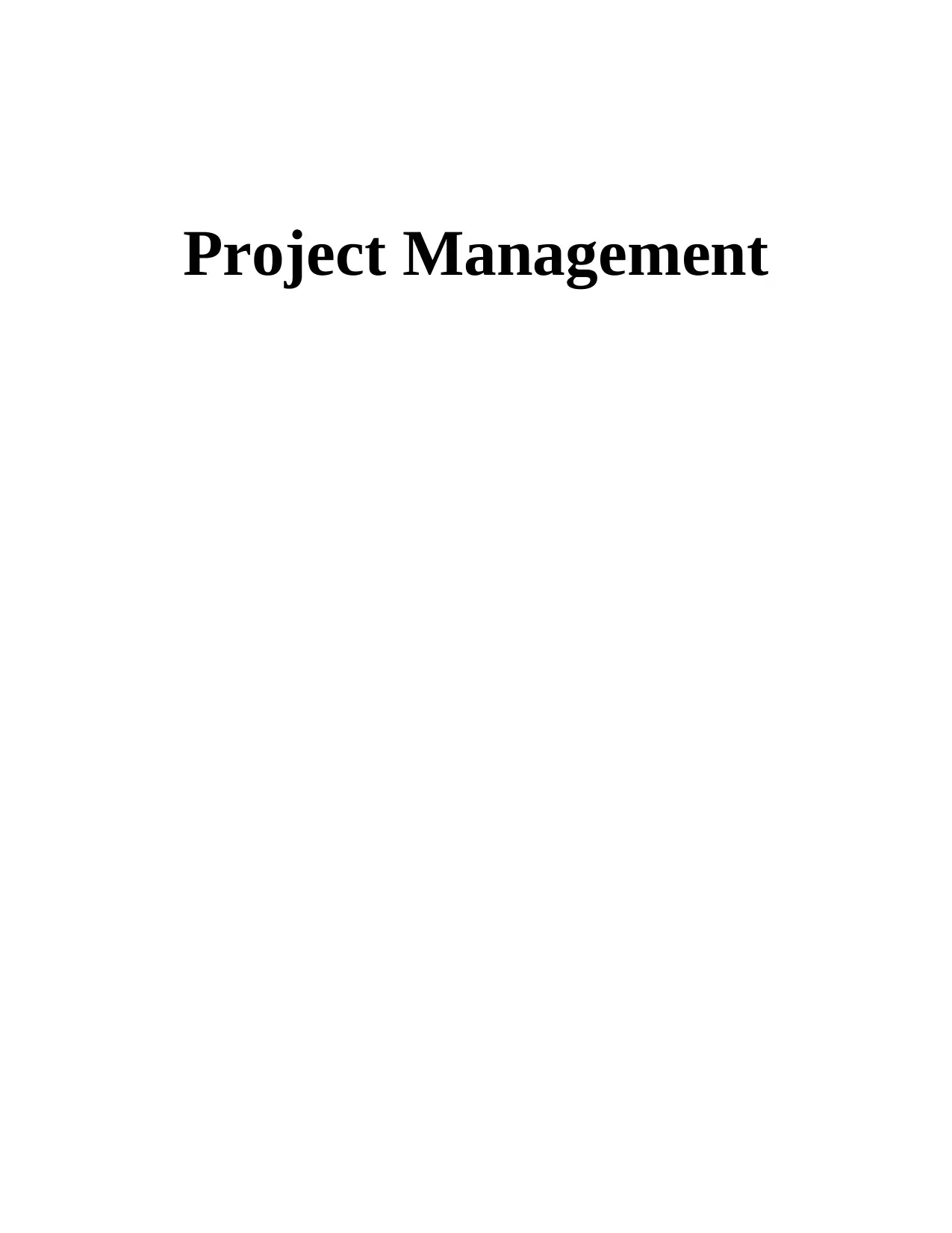
Project Management
Paraphrase This Document
Need a fresh take? Get an instant paraphrase of this document with our AI Paraphraser
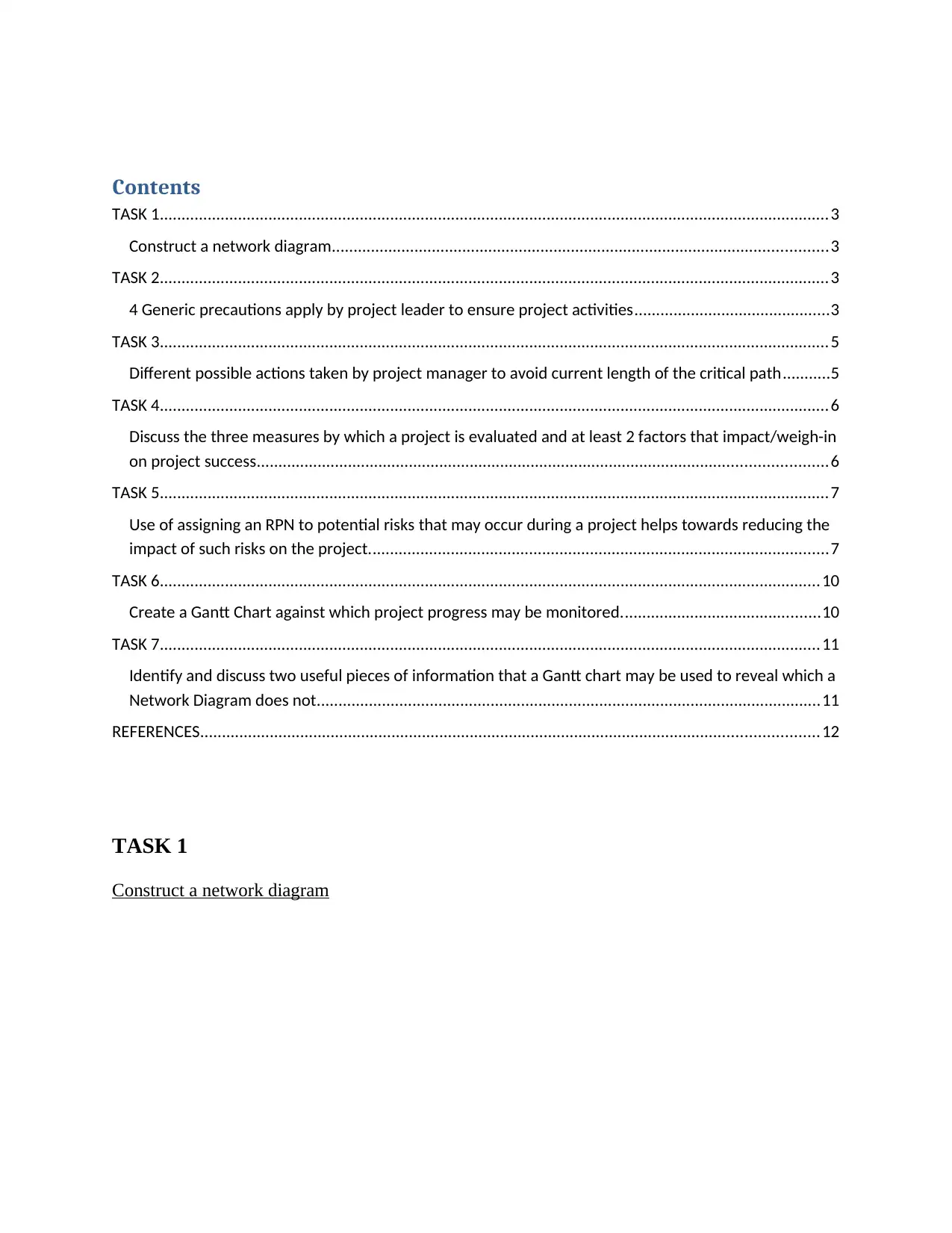
Contents
TASK 1..........................................................................................................................................................3
Construct a network diagram..................................................................................................................3
TASK 2..........................................................................................................................................................3
4 Generic precautions apply by project leader to ensure project activities.............................................3
TASK 3..........................................................................................................................................................5
Different possible actions taken by project manager to avoid current length of the critical path...........5
TASK 4..........................................................................................................................................................6
Discuss the three measures by which a project is evaluated and at least 2 factors that impact/weigh-in
on project success...................................................................................................................................6
TASK 5..........................................................................................................................................................7
Use of assigning an RPN to potential risks that may occur during a project helps towards reducing the
impact of such risks on the project..........................................................................................................7
TASK 6........................................................................................................................................................10
Create a Gantt Chart against which project progress may be monitored..............................................10
TASK 7........................................................................................................................................................11
Identify and discuss two useful pieces of information that a Gantt chart may be used to reveal which a
Network Diagram does not....................................................................................................................11
REFERENCES..............................................................................................................................................12
TASK 1
Construct a network diagram
TASK 1..........................................................................................................................................................3
Construct a network diagram..................................................................................................................3
TASK 2..........................................................................................................................................................3
4 Generic precautions apply by project leader to ensure project activities.............................................3
TASK 3..........................................................................................................................................................5
Different possible actions taken by project manager to avoid current length of the critical path...........5
TASK 4..........................................................................................................................................................6
Discuss the three measures by which a project is evaluated and at least 2 factors that impact/weigh-in
on project success...................................................................................................................................6
TASK 5..........................................................................................................................................................7
Use of assigning an RPN to potential risks that may occur during a project helps towards reducing the
impact of such risks on the project..........................................................................................................7
TASK 6........................................................................................................................................................10
Create a Gantt Chart against which project progress may be monitored..............................................10
TASK 7........................................................................................................................................................11
Identify and discuss two useful pieces of information that a Gantt chart may be used to reveal which a
Network Diagram does not....................................................................................................................11
REFERENCES..............................................................................................................................................12
TASK 1
Construct a network diagram

TASK 2
4 Generic precautions apply by project leader to ensure project activities
One of the most typical issues in project management is unanticipated delays. According to
one research, just around half of businesses completed time and within budget.
Set realistic goals for projects: Setting realistic goals is likely to be the most important aspect
that affects whether or not they will finish the job on time. It's attractive to set lofty expectations
in order to create a good first appearance or if the customer deserves it. Important goals are
attainable, quantifiable, and practical.
Realistic: Can we achieve this goal in the effort and cost we have usable?
4 Generic precautions apply by project leader to ensure project activities
One of the most typical issues in project management is unanticipated delays. According to
one research, just around half of businesses completed time and within budget.
Set realistic goals for projects: Setting realistic goals is likely to be the most important aspect
that affects whether or not they will finish the job on time. It's attractive to set lofty expectations
in order to create a good first appearance or if the customer deserves it. Important goals are
attainable, quantifiable, and practical.
Realistic: Can we achieve this goal in the effort and cost we have usable?
⊘ This is a preview!⊘
Do you want full access?
Subscribe today to unlock all pages.

Trusted by 1+ million students worldwide
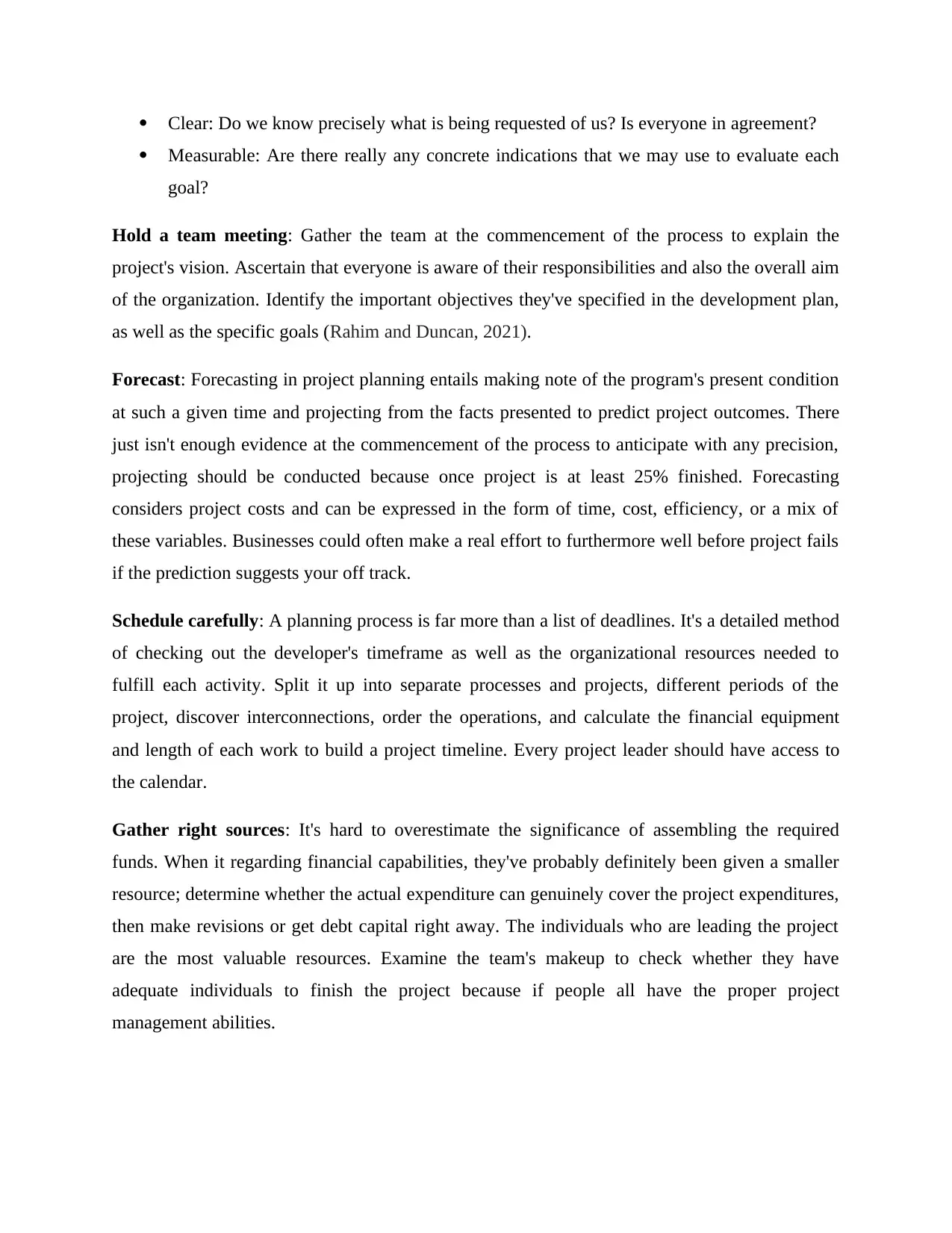
Clear: Do we know precisely what is being requested of us? Is everyone in agreement?
Measurable: Are there really any concrete indications that we may use to evaluate each
goal?
Hold a team meeting: Gather the team at the commencement of the process to explain the
project's vision. Ascertain that everyone is aware of their responsibilities and also the overall aim
of the organization. Identify the important objectives they've specified in the development plan,
as well as the specific goals (Rahim and Duncan, 2021).
Forecast: Forecasting in project planning entails making note of the program's present condition
at such a given time and projecting from the facts presented to predict project outcomes. There
just isn't enough evidence at the commencement of the process to anticipate with any precision,
projecting should be conducted because once project is at least 25% finished. Forecasting
considers project costs and can be expressed in the form of time, cost, efficiency, or a mix of
these variables. Businesses could often make a real effort to furthermore well before project fails
if the prediction suggests your off track.
Schedule carefully: A planning process is far more than a list of deadlines. It's a detailed method
of checking out the developer's timeframe as well as the organizational resources needed to
fulfill each activity. Split it up into separate processes and projects, different periods of the
project, discover interconnections, order the operations, and calculate the financial equipment
and length of each work to build a project timeline. Every project leader should have access to
the calendar.
Gather right sources: It's hard to overestimate the significance of assembling the required
funds. When it regarding financial capabilities, they've probably definitely been given a smaller
resource; determine whether the actual expenditure can genuinely cover the project expenditures,
then make revisions or get debt capital right away. The individuals who are leading the project
are the most valuable resources. Examine the team's makeup to check whether they have
adequate individuals to finish the project because if people all have the proper project
management abilities.
Measurable: Are there really any concrete indications that we may use to evaluate each
goal?
Hold a team meeting: Gather the team at the commencement of the process to explain the
project's vision. Ascertain that everyone is aware of their responsibilities and also the overall aim
of the organization. Identify the important objectives they've specified in the development plan,
as well as the specific goals (Rahim and Duncan, 2021).
Forecast: Forecasting in project planning entails making note of the program's present condition
at such a given time and projecting from the facts presented to predict project outcomes. There
just isn't enough evidence at the commencement of the process to anticipate with any precision,
projecting should be conducted because once project is at least 25% finished. Forecasting
considers project costs and can be expressed in the form of time, cost, efficiency, or a mix of
these variables. Businesses could often make a real effort to furthermore well before project fails
if the prediction suggests your off track.
Schedule carefully: A planning process is far more than a list of deadlines. It's a detailed method
of checking out the developer's timeframe as well as the organizational resources needed to
fulfill each activity. Split it up into separate processes and projects, different periods of the
project, discover interconnections, order the operations, and calculate the financial equipment
and length of each work to build a project timeline. Every project leader should have access to
the calendar.
Gather right sources: It's hard to overestimate the significance of assembling the required
funds. When it regarding financial capabilities, they've probably definitely been given a smaller
resource; determine whether the actual expenditure can genuinely cover the project expenditures,
then make revisions or get debt capital right away. The individuals who are leading the project
are the most valuable resources. Examine the team's makeup to check whether they have
adequate individuals to finish the project because if people all have the proper project
management abilities.
Paraphrase This Document
Need a fresh take? Get an instant paraphrase of this document with our AI Paraphraser
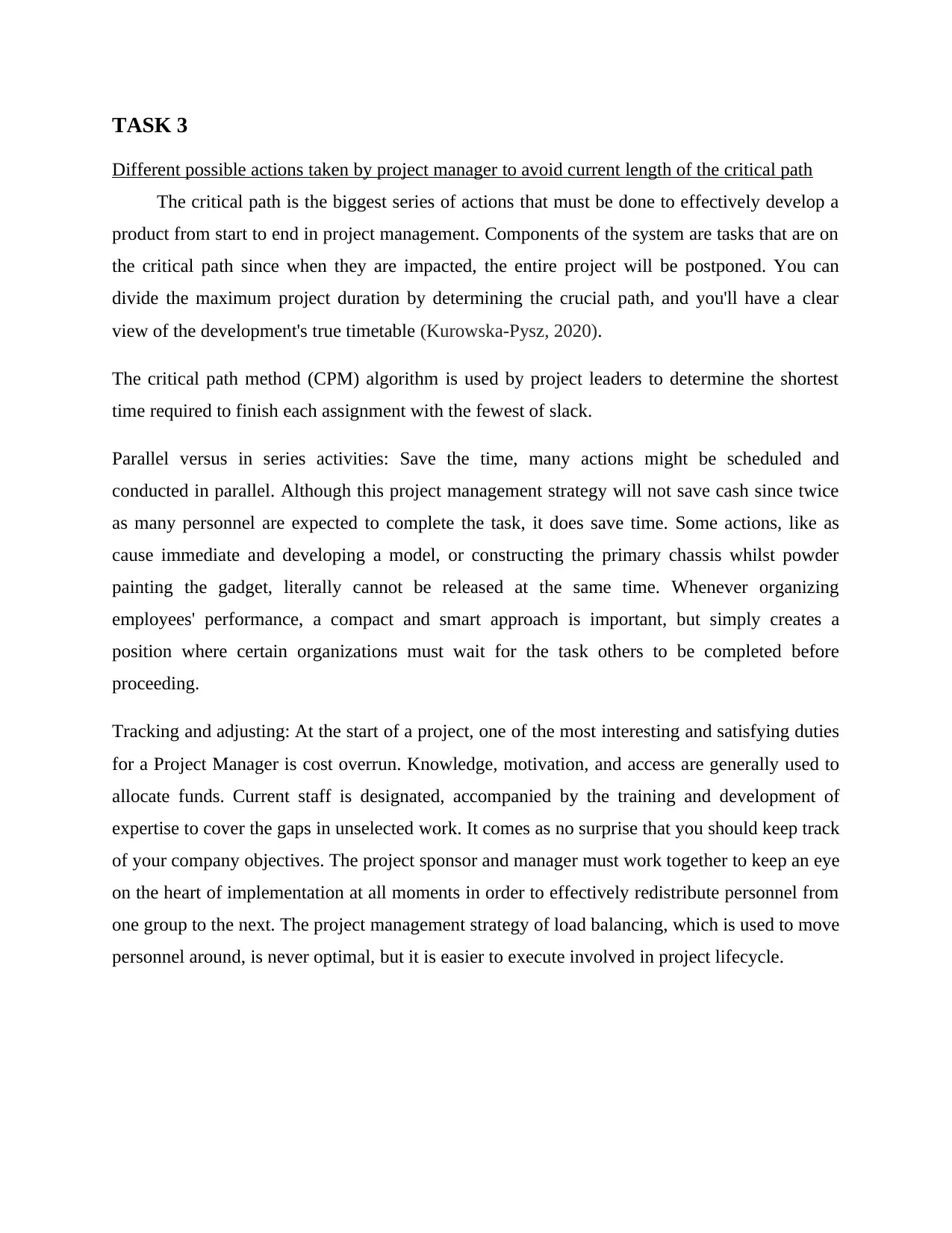
TASK 3
Different possible actions taken by project manager to avoid current length of the critical path
The critical path is the biggest series of actions that must be done to effectively develop a
product from start to end in project management. Components of the system are tasks that are on
the critical path since when they are impacted, the entire project will be postponed. You can
divide the maximum project duration by determining the crucial path, and you'll have a clear
view of the development's true timetable (Kurowska-Pysz, 2020).
The critical path method (CPM) algorithm is used by project leaders to determine the shortest
time required to finish each assignment with the fewest of slack.
Parallel versus in series activities: Save the time, many actions might be scheduled and
conducted in parallel. Although this project management strategy will not save cash since twice
as many personnel are expected to complete the task, it does save time. Some actions, like as
cause immediate and developing a model, or constructing the primary chassis whilst powder
painting the gadget, literally cannot be released at the same time. Whenever organizing
employees' performance, a compact and smart approach is important, but simply creates a
position where certain organizations must wait for the task others to be completed before
proceeding.
Tracking and adjusting: At the start of a project, one of the most interesting and satisfying duties
for a Project Manager is cost overrun. Knowledge, motivation, and access are generally used to
allocate funds. Current staff is designated, accompanied by the training and development of
expertise to cover the gaps in unselected work. It comes as no surprise that you should keep track
of your company objectives. The project sponsor and manager must work together to keep an eye
on the heart of implementation at all moments in order to effectively redistribute personnel from
one group to the next. The project management strategy of load balancing, which is used to move
personnel around, is never optimal, but it is easier to execute involved in project lifecycle.
Different possible actions taken by project manager to avoid current length of the critical path
The critical path is the biggest series of actions that must be done to effectively develop a
product from start to end in project management. Components of the system are tasks that are on
the critical path since when they are impacted, the entire project will be postponed. You can
divide the maximum project duration by determining the crucial path, and you'll have a clear
view of the development's true timetable (Kurowska-Pysz, 2020).
The critical path method (CPM) algorithm is used by project leaders to determine the shortest
time required to finish each assignment with the fewest of slack.
Parallel versus in series activities: Save the time, many actions might be scheduled and
conducted in parallel. Although this project management strategy will not save cash since twice
as many personnel are expected to complete the task, it does save time. Some actions, like as
cause immediate and developing a model, or constructing the primary chassis whilst powder
painting the gadget, literally cannot be released at the same time. Whenever organizing
employees' performance, a compact and smart approach is important, but simply creates a
position where certain organizations must wait for the task others to be completed before
proceeding.
Tracking and adjusting: At the start of a project, one of the most interesting and satisfying duties
for a Project Manager is cost overrun. Knowledge, motivation, and access are generally used to
allocate funds. Current staff is designated, accompanied by the training and development of
expertise to cover the gaps in unselected work. It comes as no surprise that you should keep track
of your company objectives. The project sponsor and manager must work together to keep an eye
on the heart of implementation at all moments in order to effectively redistribute personnel from
one group to the next. The project management strategy of load balancing, which is used to move
personnel around, is never optimal, but it is easier to execute involved in project lifecycle.
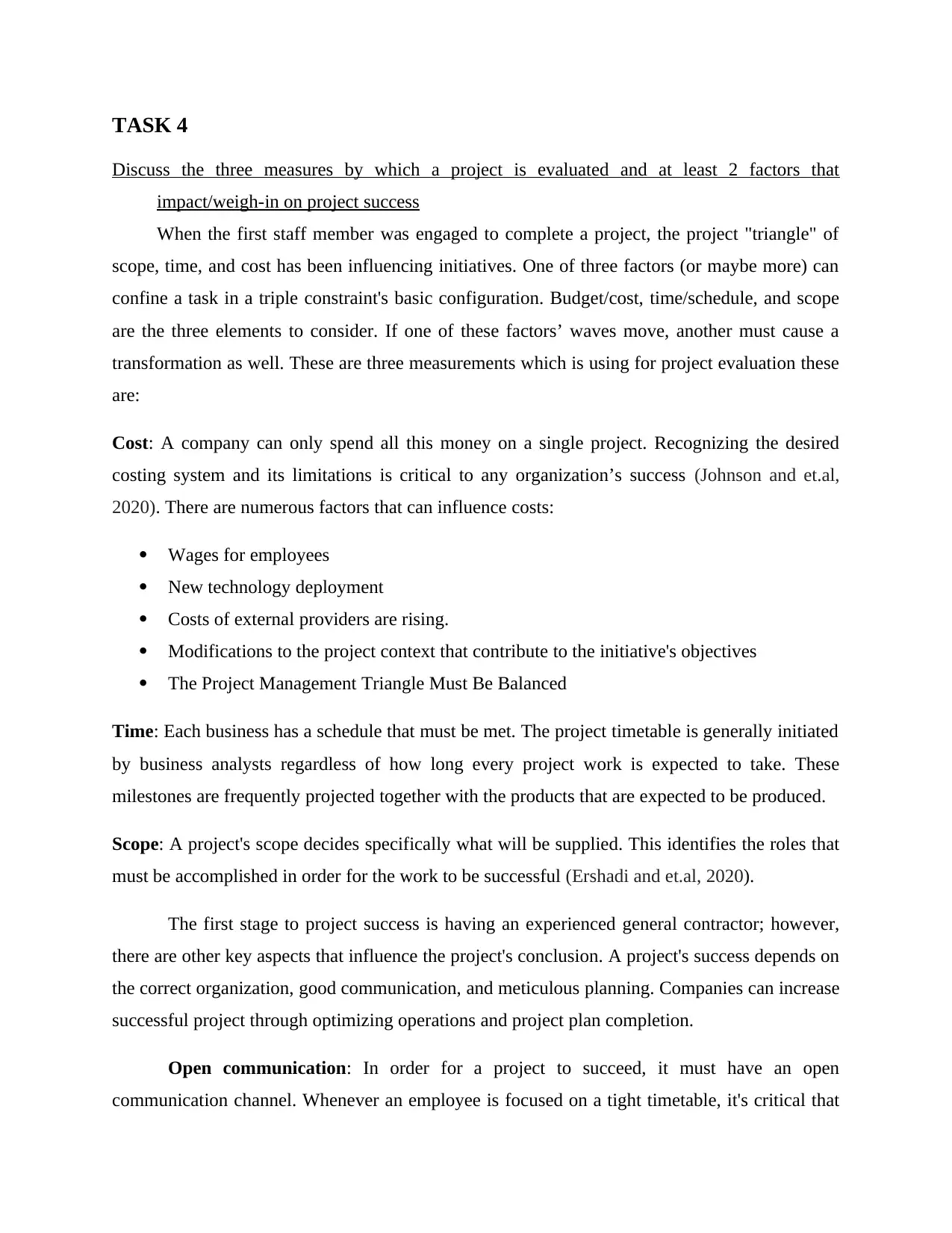
TASK 4
Discuss the three measures by which a project is evaluated and at least 2 factors that
impact/weigh-in on project success
When the first staff member was engaged to complete a project, the project "triangle" of
scope, time, and cost has been influencing initiatives. One of three factors (or maybe more) can
confine a task in a triple constraint's basic configuration. Budget/cost, time/schedule, and scope
are the three elements to consider. If one of these factors’ waves move, another must cause a
transformation as well. These are three measurements which is using for project evaluation these
are:
Cost: A company can only spend all this money on a single project. Recognizing the desired
costing system and its limitations is critical to any organization’s success (Johnson and et.al,
2020). There are numerous factors that can influence costs:
Wages for employees
New technology deployment
Costs of external providers are rising.
Modifications to the project context that contribute to the initiative's objectives
The Project Management Triangle Must Be Balanced
Time: Each business has a schedule that must be met. The project timetable is generally initiated
by business analysts regardless of how long every project work is expected to take. These
milestones are frequently projected together with the products that are expected to be produced.
Scope: A project's scope decides specifically what will be supplied. This identifies the roles that
must be accomplished in order for the work to be successful (Ershadi and et.al, 2020).
The first stage to project success is having an experienced general contractor; however,
there are other key aspects that influence the project's conclusion. A project's success depends on
the correct organization, good communication, and meticulous planning. Companies can increase
successful project through optimizing operations and project plan completion.
Open communication: In order for a project to succeed, it must have an open
communication channel. Whenever an employee is focused on a tight timetable, it's critical that
Discuss the three measures by which a project is evaluated and at least 2 factors that
impact/weigh-in on project success
When the first staff member was engaged to complete a project, the project "triangle" of
scope, time, and cost has been influencing initiatives. One of three factors (or maybe more) can
confine a task in a triple constraint's basic configuration. Budget/cost, time/schedule, and scope
are the three elements to consider. If one of these factors’ waves move, another must cause a
transformation as well. These are three measurements which is using for project evaluation these
are:
Cost: A company can only spend all this money on a single project. Recognizing the desired
costing system and its limitations is critical to any organization’s success (Johnson and et.al,
2020). There are numerous factors that can influence costs:
Wages for employees
New technology deployment
Costs of external providers are rising.
Modifications to the project context that contribute to the initiative's objectives
The Project Management Triangle Must Be Balanced
Time: Each business has a schedule that must be met. The project timetable is generally initiated
by business analysts regardless of how long every project work is expected to take. These
milestones are frequently projected together with the products that are expected to be produced.
Scope: A project's scope decides specifically what will be supplied. This identifies the roles that
must be accomplished in order for the work to be successful (Ershadi and et.al, 2020).
The first stage to project success is having an experienced general contractor; however,
there are other key aspects that influence the project's conclusion. A project's success depends on
the correct organization, good communication, and meticulous planning. Companies can increase
successful project through optimizing operations and project plan completion.
Open communication: In order for a project to succeed, it must have an open
communication channel. Whenever an employee is focused on a tight timetable, it's critical that
⊘ This is a preview!⊘
Do you want full access?
Subscribe today to unlock all pages.

Trusted by 1+ million students worldwide
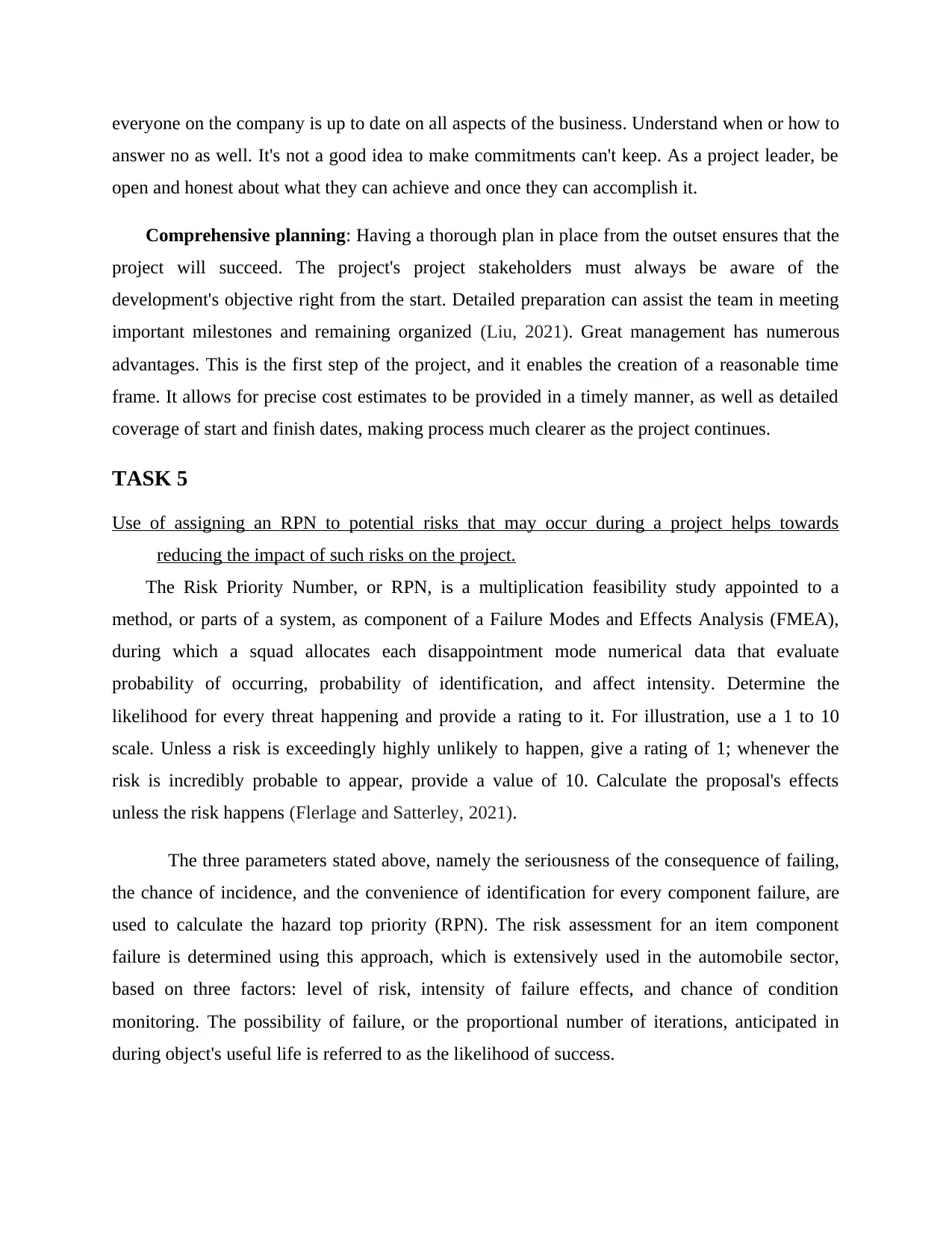
everyone on the company is up to date on all aspects of the business. Understand when or how to
answer no as well. It's not a good idea to make commitments can't keep. As a project leader, be
open and honest about what they can achieve and once they can accomplish it.
Comprehensive planning: Having a thorough plan in place from the outset ensures that the
project will succeed. The project's project stakeholders must always be aware of the
development's objective right from the start. Detailed preparation can assist the team in meeting
important milestones and remaining organized (Liu, 2021). Great management has numerous
advantages. This is the first step of the project, and it enables the creation of a reasonable time
frame. It allows for precise cost estimates to be provided in a timely manner, as well as detailed
coverage of start and finish dates, making process much clearer as the project continues.
TASK 5
Use of assigning an RPN to potential risks that may occur during a project helps towards
reducing the impact of such risks on the project.
The Risk Priority Number, or RPN, is a multiplication feasibility study appointed to a
method, or parts of a system, as component of a Failure Modes and Effects Analysis (FMEA),
during which a squad allocates each disappointment mode numerical data that evaluate
probability of occurring, probability of identification, and affect intensity. Determine the
likelihood for every threat happening and provide a rating to it. For illustration, use a 1 to 10
scale. Unless a risk is exceedingly highly unlikely to happen, give a rating of 1; whenever the
risk is incredibly probable to appear, provide a value of 10. Calculate the proposal's effects
unless the risk happens (Flerlage and Satterley, 2021).
The three parameters stated above, namely the seriousness of the consequence of failing,
the chance of incidence, and the convenience of identification for every component failure, are
used to calculate the hazard top priority (RPN). The risk assessment for an item component
failure is determined using this approach, which is extensively used in the automobile sector,
based on three factors: level of risk, intensity of failure effects, and chance of condition
monitoring. The possibility of failure, or the proportional number of iterations, anticipated in
during object's useful life is referred to as the likelihood of success.
answer no as well. It's not a good idea to make commitments can't keep. As a project leader, be
open and honest about what they can achieve and once they can accomplish it.
Comprehensive planning: Having a thorough plan in place from the outset ensures that the
project will succeed. The project's project stakeholders must always be aware of the
development's objective right from the start. Detailed preparation can assist the team in meeting
important milestones and remaining organized (Liu, 2021). Great management has numerous
advantages. This is the first step of the project, and it enables the creation of a reasonable time
frame. It allows for precise cost estimates to be provided in a timely manner, as well as detailed
coverage of start and finish dates, making process much clearer as the project continues.
TASK 5
Use of assigning an RPN to potential risks that may occur during a project helps towards
reducing the impact of such risks on the project.
The Risk Priority Number, or RPN, is a multiplication feasibility study appointed to a
method, or parts of a system, as component of a Failure Modes and Effects Analysis (FMEA),
during which a squad allocates each disappointment mode numerical data that evaluate
probability of occurring, probability of identification, and affect intensity. Determine the
likelihood for every threat happening and provide a rating to it. For illustration, use a 1 to 10
scale. Unless a risk is exceedingly highly unlikely to happen, give a rating of 1; whenever the
risk is incredibly probable to appear, provide a value of 10. Calculate the proposal's effects
unless the risk happens (Flerlage and Satterley, 2021).
The three parameters stated above, namely the seriousness of the consequence of failing,
the chance of incidence, and the convenience of identification for every component failure, are
used to calculate the hazard top priority (RPN). The risk assessment for an item component
failure is determined using this approach, which is extensively used in the automobile sector,
based on three factors: level of risk, intensity of failure effects, and chance of condition
monitoring. The possibility of failure, or the proportional number of iterations, anticipated in
during object's useful life is referred to as the likelihood of success.
Paraphrase This Document
Need a fresh take? Get an instant paraphrase of this document with our AI Paraphraser
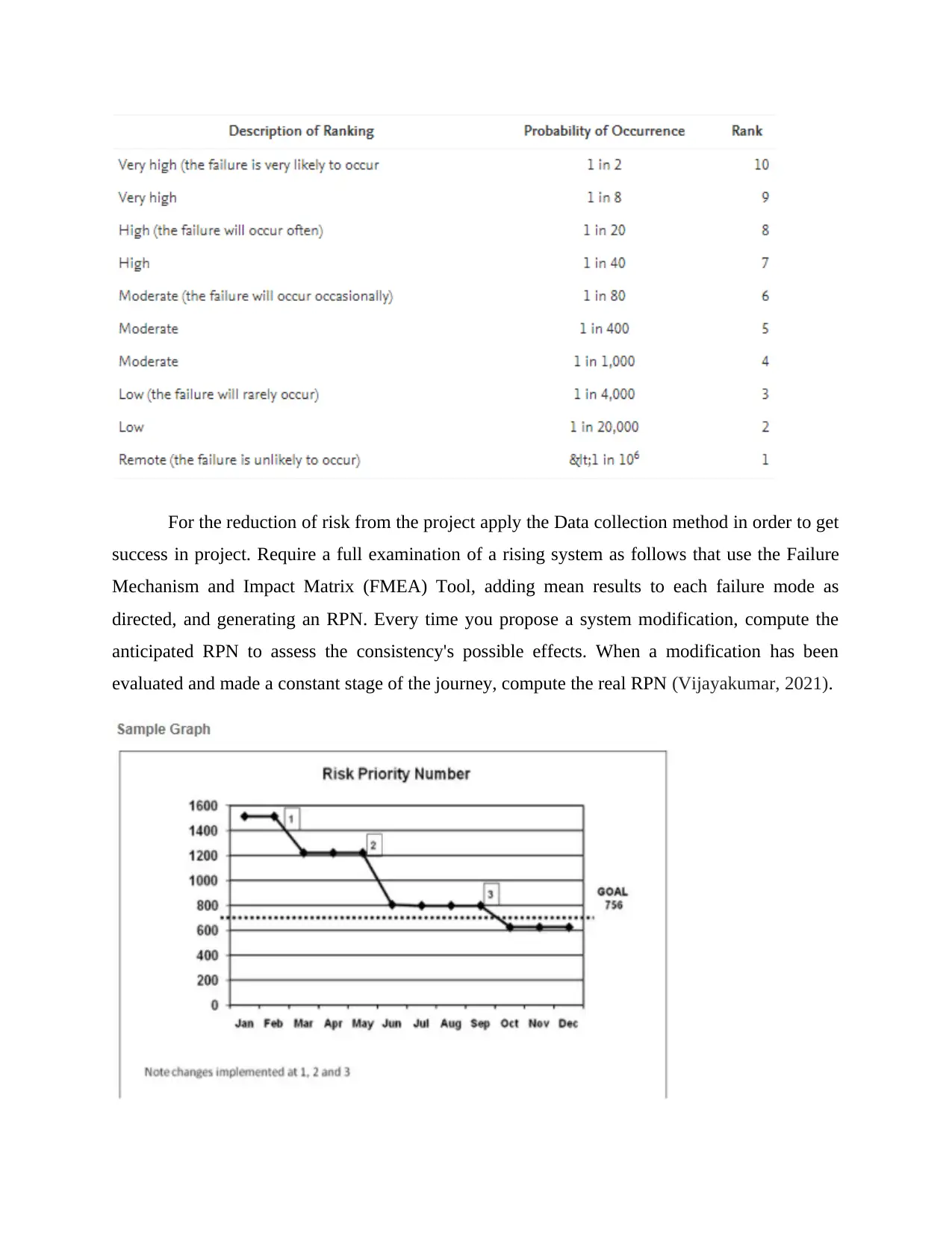
For the reduction of risk from the project apply the Data collection method in order to get
success in project. Require a full examination of a rising system as follows that use the Failure
Mechanism and Impact Matrix (FMEA) Tool, adding mean results to each failure mode as
directed, and generating an RPN. Every time you propose a system modification, compute the
anticipated RPN to assess the consistency's possible effects. When a modification has been
evaluated and made a constant stage of the journey, compute the real RPN (Vijayakumar, 2021).
success in project. Require a full examination of a rising system as follows that use the Failure
Mechanism and Impact Matrix (FMEA) Tool, adding mean results to each failure mode as
directed, and generating an RPN. Every time you propose a system modification, compute the
anticipated RPN to assess the consistency's possible effects. When a modification has been
evaluated and made a constant stage of the journey, compute the real RPN (Vijayakumar, 2021).
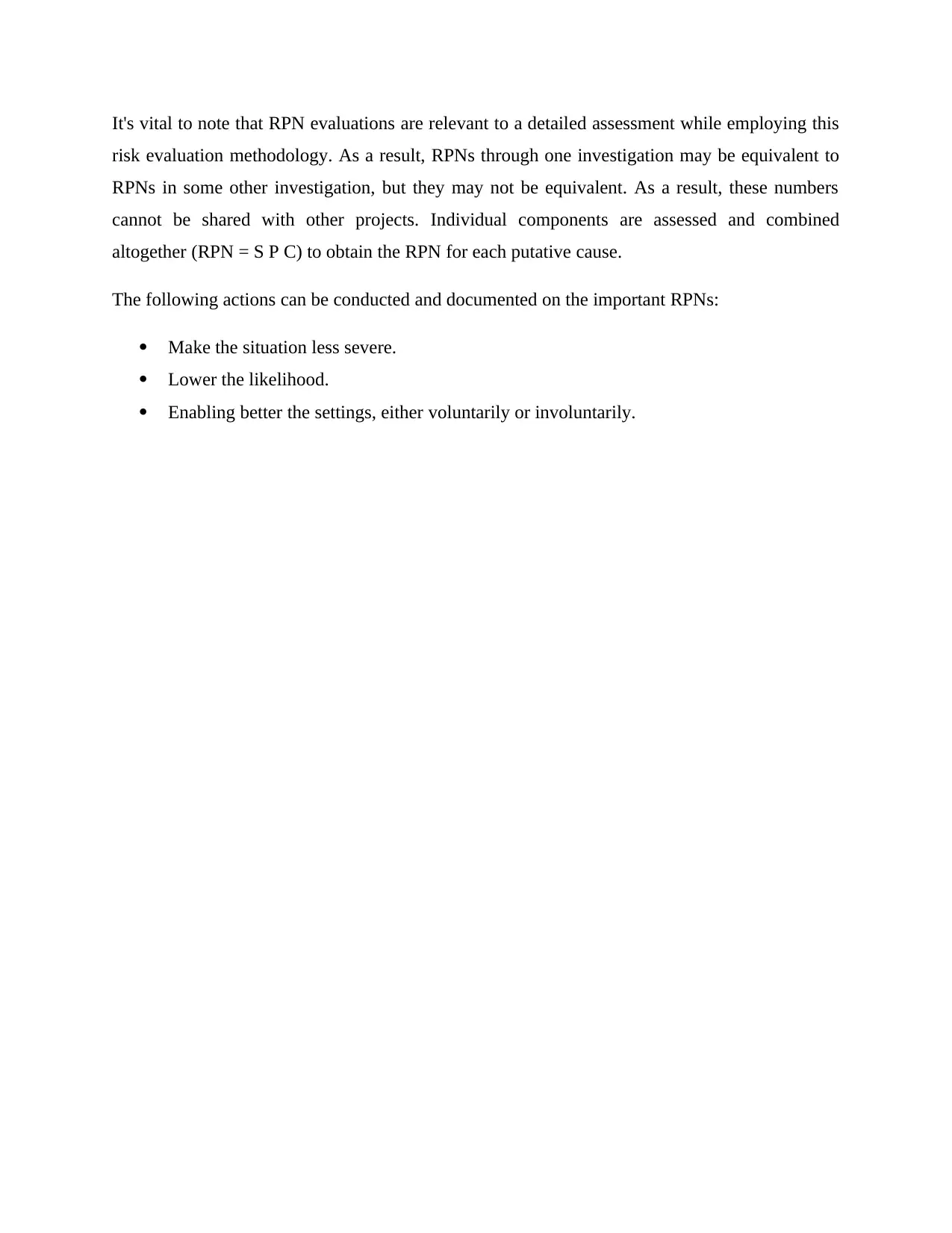
It's vital to note that RPN evaluations are relevant to a detailed assessment while employing this
risk evaluation methodology. As a result, RPNs through one investigation may be equivalent to
RPNs in some other investigation, but they may not be equivalent. As a result, these numbers
cannot be shared with other projects. Individual components are assessed and combined
altogether (RPN = S P C) to obtain the RPN for each putative cause.
The following actions can be conducted and documented on the important RPNs:
Make the situation less severe.
Lower the likelihood.
Enabling better the settings, either voluntarily or involuntarily.
risk evaluation methodology. As a result, RPNs through one investigation may be equivalent to
RPNs in some other investigation, but they may not be equivalent. As a result, these numbers
cannot be shared with other projects. Individual components are assessed and combined
altogether (RPN = S P C) to obtain the RPN for each putative cause.
The following actions can be conducted and documented on the important RPNs:
Make the situation less severe.
Lower the likelihood.
Enabling better the settings, either voluntarily or involuntarily.
⊘ This is a preview!⊘
Do you want full access?
Subscribe today to unlock all pages.

Trusted by 1+ million students worldwide
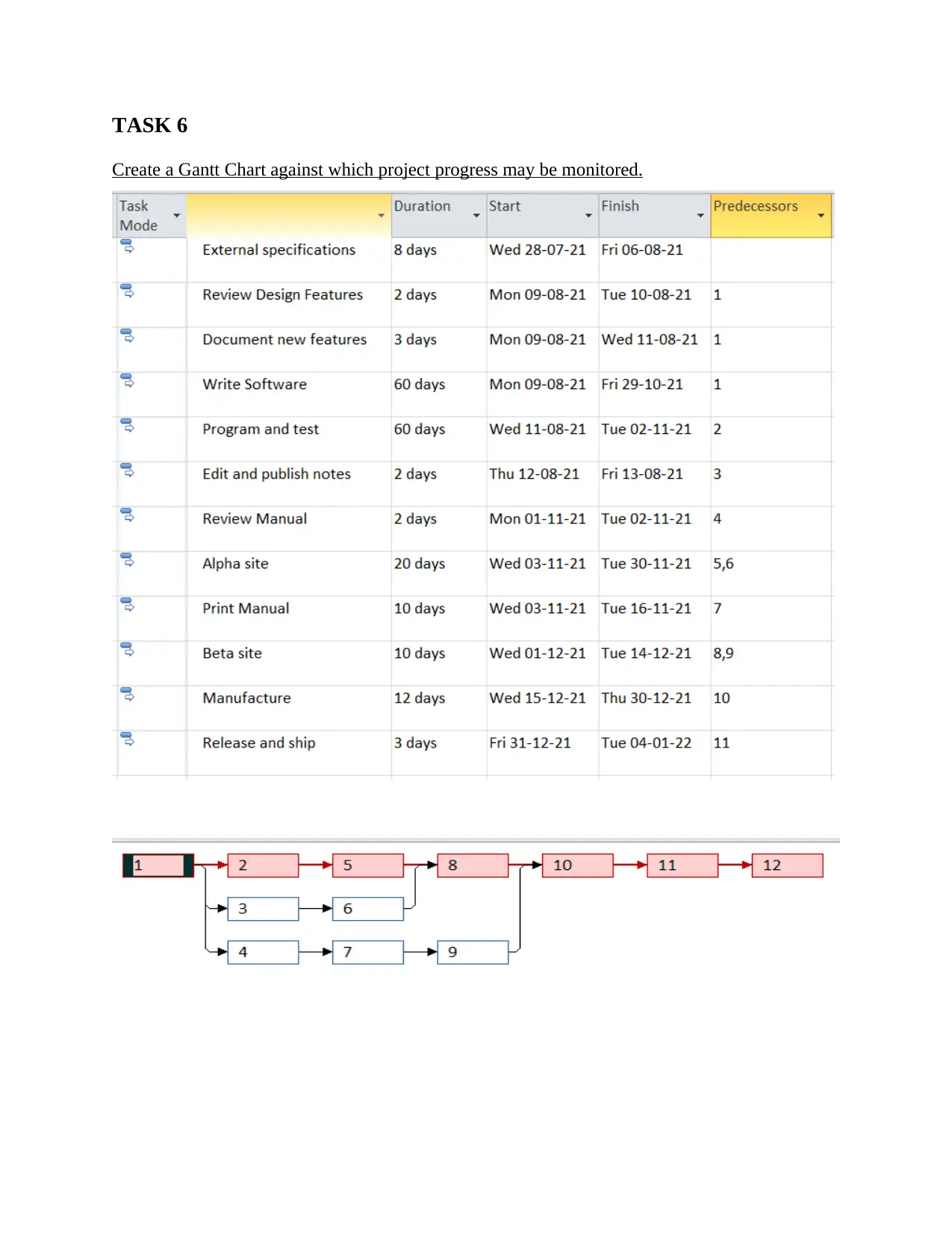
TASK 6
Create a Gantt Chart against which project progress may be monitored.
Create a Gantt Chart against which project progress may be monitored.
Paraphrase This Document
Need a fresh take? Get an instant paraphrase of this document with our AI Paraphraser
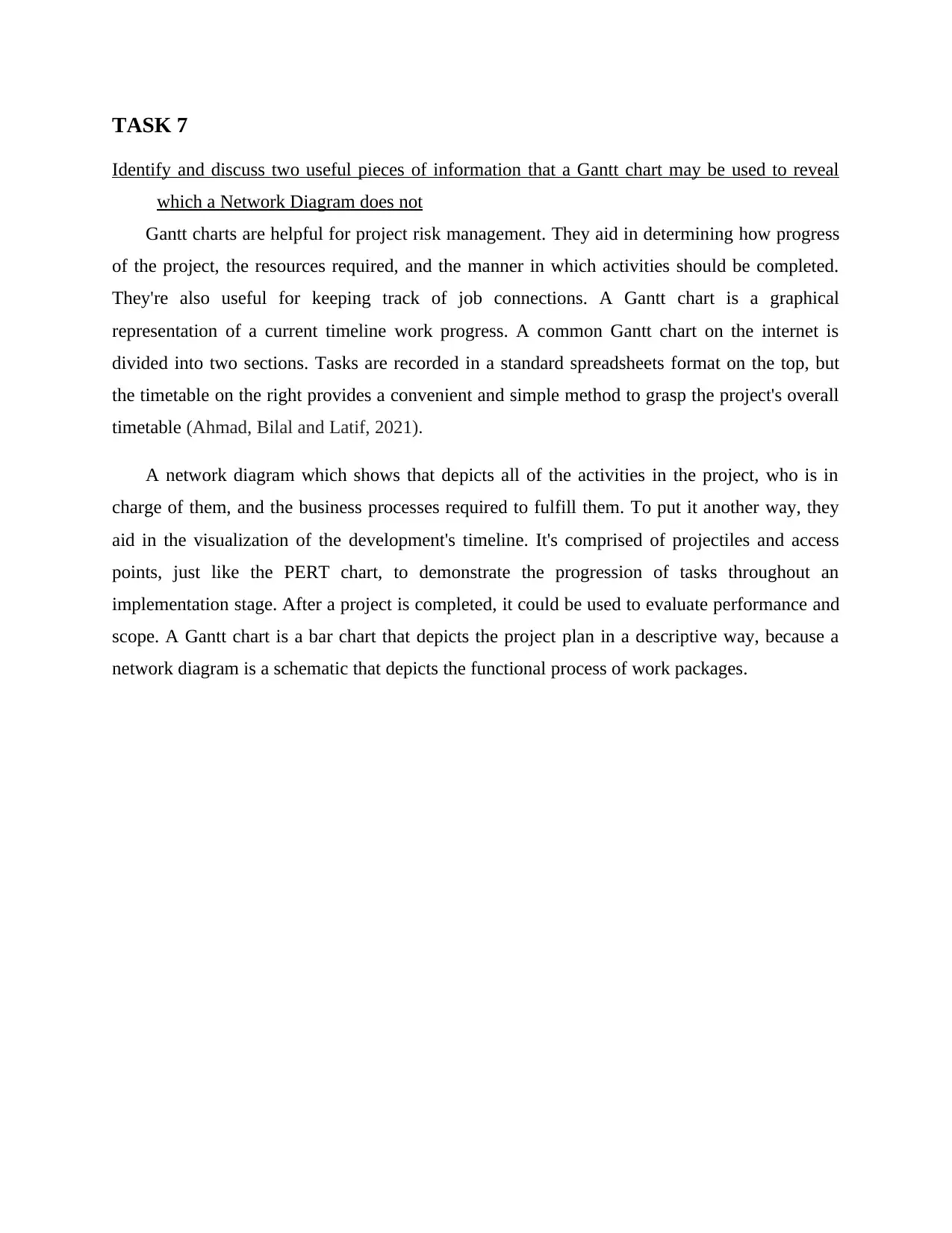
TASK 7
Identify and discuss two useful pieces of information that a Gantt chart may be used to reveal
which a Network Diagram does not
Gantt charts are helpful for project risk management. They aid in determining how progress
of the project, the resources required, and the manner in which activities should be completed.
They're also useful for keeping track of job connections. A Gantt chart is a graphical
representation of a current timeline work progress. A common Gantt chart on the internet is
divided into two sections. Tasks are recorded in a standard spreadsheets format on the top, but
the timetable on the right provides a convenient and simple method to grasp the project's overall
timetable (Ahmad, Bilal and Latif, 2021).
A network diagram which shows that depicts all of the activities in the project, who is in
charge of them, and the business processes required to fulfill them. To put it another way, they
aid in the visualization of the development's timeline. It's comprised of projectiles and access
points, just like the PERT chart, to demonstrate the progression of tasks throughout an
implementation stage. After a project is completed, it could be used to evaluate performance and
scope. A Gantt chart is a bar chart that depicts the project plan in a descriptive way, because a
network diagram is a schematic that depicts the functional process of work packages.
Identify and discuss two useful pieces of information that a Gantt chart may be used to reveal
which a Network Diagram does not
Gantt charts are helpful for project risk management. They aid in determining how progress
of the project, the resources required, and the manner in which activities should be completed.
They're also useful for keeping track of job connections. A Gantt chart is a graphical
representation of a current timeline work progress. A common Gantt chart on the internet is
divided into two sections. Tasks are recorded in a standard spreadsheets format on the top, but
the timetable on the right provides a convenient and simple method to grasp the project's overall
timetable (Ahmad, Bilal and Latif, 2021).
A network diagram which shows that depicts all of the activities in the project, who is in
charge of them, and the business processes required to fulfill them. To put it another way, they
aid in the visualization of the development's timeline. It's comprised of projectiles and access
points, just like the PERT chart, to demonstrate the progression of tasks throughout an
implementation stage. After a project is completed, it could be used to evaluate performance and
scope. A Gantt chart is a bar chart that depicts the project plan in a descriptive way, because a
network diagram is a schematic that depicts the functional process of work packages.
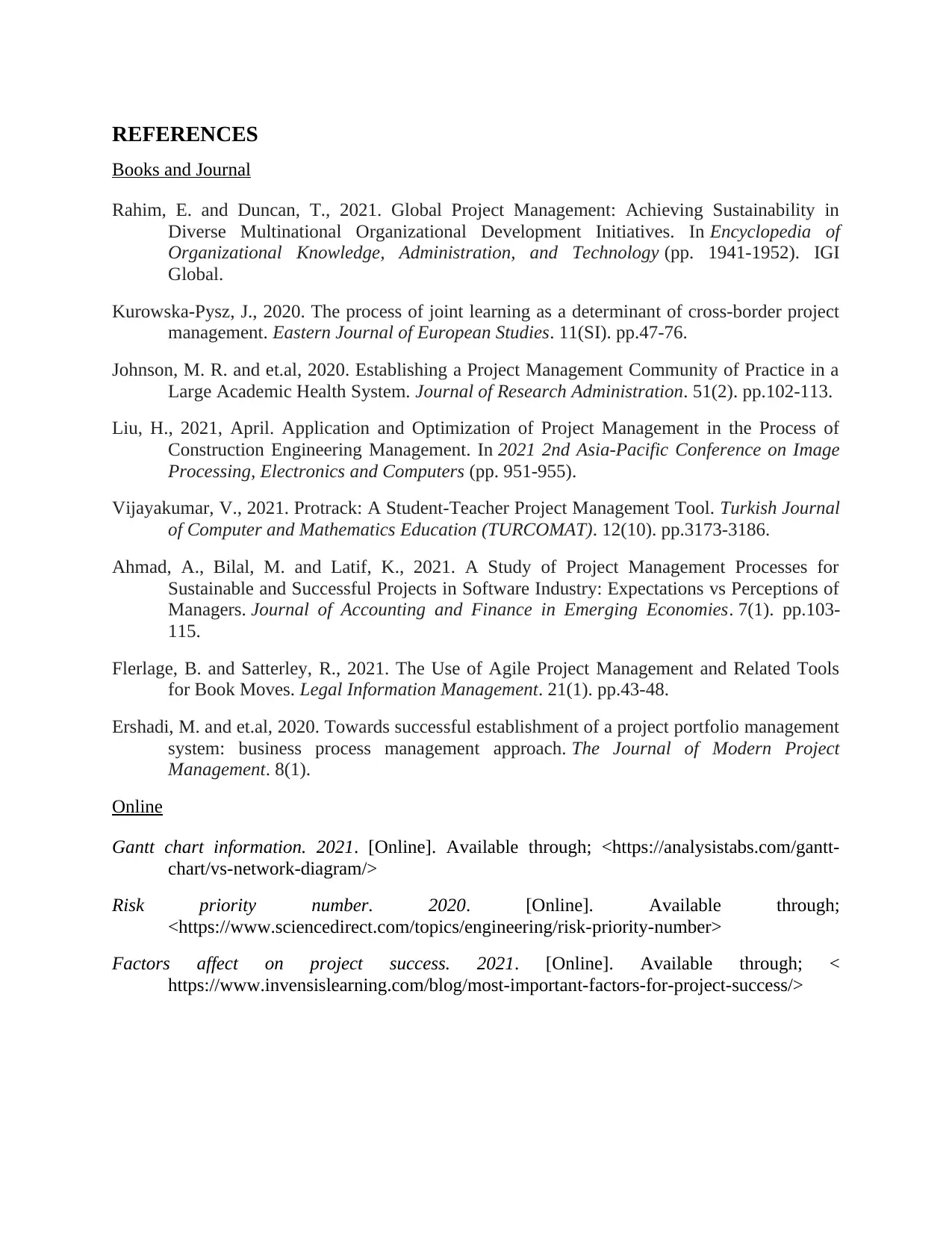
REFERENCES
Books and Journal
Rahim, E. and Duncan, T., 2021. Global Project Management: Achieving Sustainability in
Diverse Multinational Organizational Development Initiatives. In Encyclopedia of
Organizational Knowledge, Administration, and Technology (pp. 1941-1952). IGI
Global.
Kurowska-Pysz, J., 2020. The process of joint learning as a determinant of cross-border project
management. Eastern Journal of European Studies. 11(SI). pp.47-76.
Johnson, M. R. and et.al, 2020. Establishing a Project Management Community of Practice in a
Large Academic Health System. Journal of Research Administration. 51(2). pp.102-113.
Liu, H., 2021, April. Application and Optimization of Project Management in the Process of
Construction Engineering Management. In 2021 2nd Asia-Pacific Conference on Image
Processing, Electronics and Computers (pp. 951-955).
Vijayakumar, V., 2021. Protrack: A Student-Teacher Project Management Tool. Turkish Journal
of Computer and Mathematics Education (TURCOMAT). 12(10). pp.3173-3186.
Ahmad, A., Bilal, M. and Latif, K., 2021. A Study of Project Management Processes for
Sustainable and Successful Projects in Software Industry: Expectations vs Perceptions of
Managers. Journal of Accounting and Finance in Emerging Economies. 7(1). pp.103-
115.
Flerlage, B. and Satterley, R., 2021. The Use of Agile Project Management and Related Tools
for Book Moves. Legal Information Management. 21(1). pp.43-48.
Ershadi, M. and et.al, 2020. Towards successful establishment of a project portfolio management
system: business process management approach. The Journal of Modern Project
Management. 8(1).
Online
Gantt chart information. 2021. [Online]. Available through; <https://analysistabs.com/gantt-
chart/vs-network-diagram/>
Risk priority number. 2020. [Online]. Available through;
<https://www.sciencedirect.com/topics/engineering/risk-priority-number>
Factors affect on project success. 2021. [Online]. Available through; <
https://www.invensislearning.com/blog/most-important-factors-for-project-success/>
Books and Journal
Rahim, E. and Duncan, T., 2021. Global Project Management: Achieving Sustainability in
Diverse Multinational Organizational Development Initiatives. In Encyclopedia of
Organizational Knowledge, Administration, and Technology (pp. 1941-1952). IGI
Global.
Kurowska-Pysz, J., 2020. The process of joint learning as a determinant of cross-border project
management. Eastern Journal of European Studies. 11(SI). pp.47-76.
Johnson, M. R. and et.al, 2020. Establishing a Project Management Community of Practice in a
Large Academic Health System. Journal of Research Administration. 51(2). pp.102-113.
Liu, H., 2021, April. Application and Optimization of Project Management in the Process of
Construction Engineering Management. In 2021 2nd Asia-Pacific Conference on Image
Processing, Electronics and Computers (pp. 951-955).
Vijayakumar, V., 2021. Protrack: A Student-Teacher Project Management Tool. Turkish Journal
of Computer and Mathematics Education (TURCOMAT). 12(10). pp.3173-3186.
Ahmad, A., Bilal, M. and Latif, K., 2021. A Study of Project Management Processes for
Sustainable and Successful Projects in Software Industry: Expectations vs Perceptions of
Managers. Journal of Accounting and Finance in Emerging Economies. 7(1). pp.103-
115.
Flerlage, B. and Satterley, R., 2021. The Use of Agile Project Management and Related Tools
for Book Moves. Legal Information Management. 21(1). pp.43-48.
Ershadi, M. and et.al, 2020. Towards successful establishment of a project portfolio management
system: business process management approach. The Journal of Modern Project
Management. 8(1).
Online
Gantt chart information. 2021. [Online]. Available through; <https://analysistabs.com/gantt-
chart/vs-network-diagram/>
Risk priority number. 2020. [Online]. Available through;
<https://www.sciencedirect.com/topics/engineering/risk-priority-number>
Factors affect on project success. 2021. [Online]. Available through; <
https://www.invensislearning.com/blog/most-important-factors-for-project-success/>
⊘ This is a preview!⊘
Do you want full access?
Subscribe today to unlock all pages.

Trusted by 1+ million students worldwide
1 out of 12
Related Documents
Your All-in-One AI-Powered Toolkit for Academic Success.
+13062052269
info@desklib.com
Available 24*7 on WhatsApp / Email
![[object Object]](/_next/static/media/star-bottom.7253800d.svg)
Unlock your academic potential
Copyright © 2020–2025 A2Z Services. All Rights Reserved. Developed and managed by ZUCOL.





